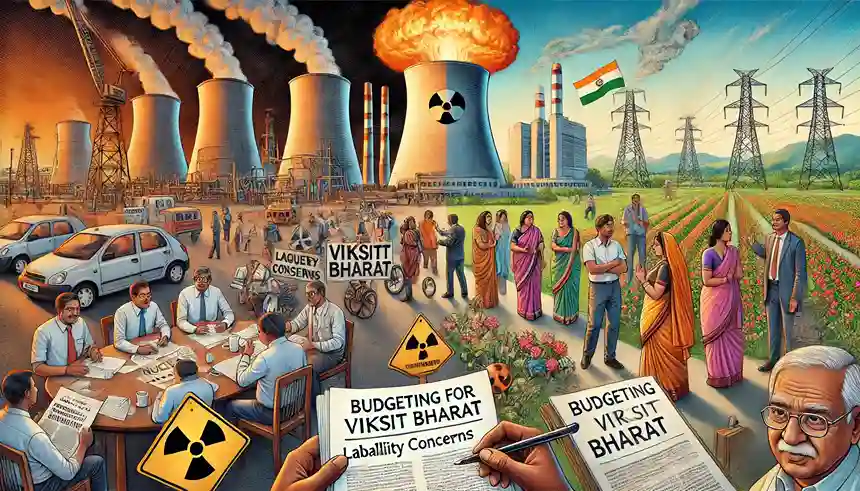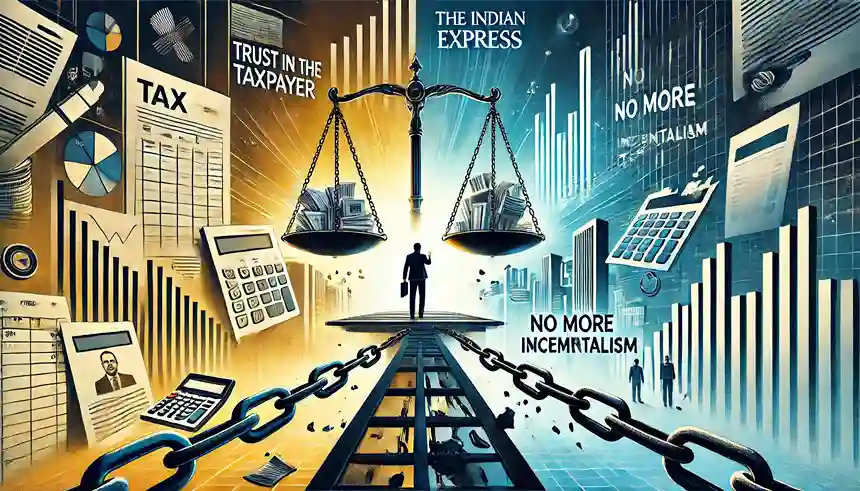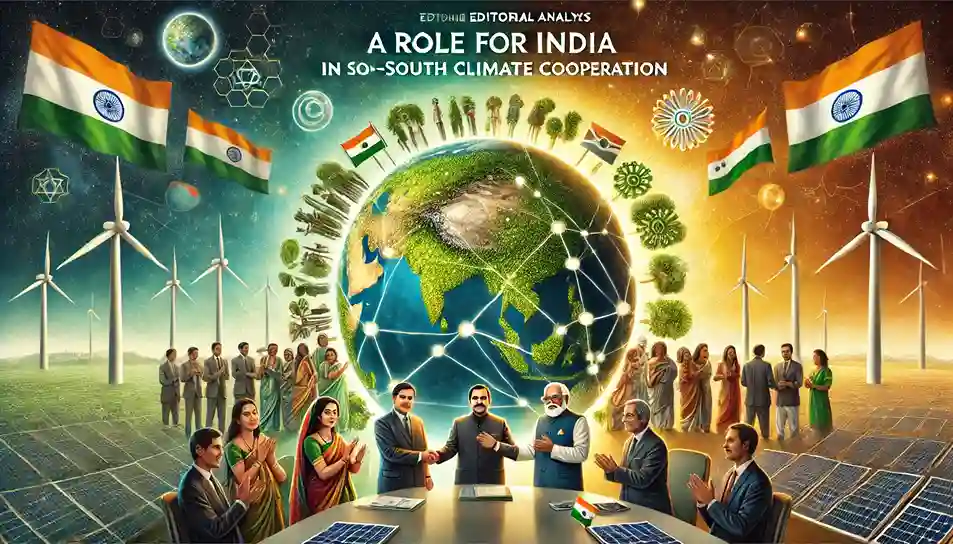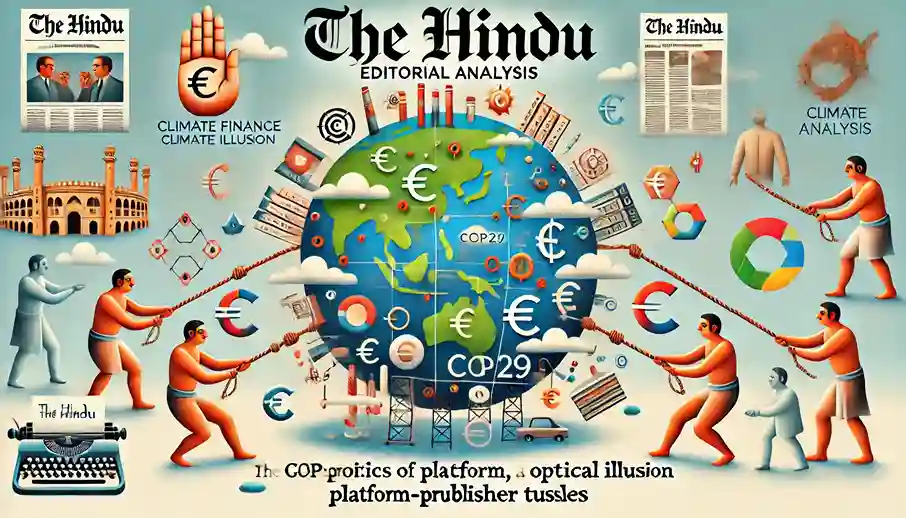Analysis of Indian Express Editorial 1: On Way to Climate Resilience
Context
As the world grapples with the effects of climate change and technological advances, nations are finding themselves at critical crossroads. On one hand, the urgency to adapt and strengthen climate resilience is more pressing than ever. On the other, emerging technologies like artificial intelligence (AI) are reshaping industries and economies at a rapid pace. These two global trends—climate adaptation and AI innovation—are particularly significant for developing nations like India, where the impacts of climate change are felt more acutely, and technological advancements offer vast potential for growth.
- Analysis of The Indian Express Editorial – February 13, 2025

- Analysis of The Hindu Editorial – February 13, 2025

- Analysis of The Indian Express Editorial – February 12, 2025

- Analysis of The Hindu Editorial – February 12, 2025

- Analysis of The Hindu Editorial – January 1, 2025

In this analysis, we will explore two key areas:
- Climate Resilience: How the Global Goal on Adaptation (GGA) framework is helping countries, especially developing ones, bolster their defenses against climate impacts.
- Artificial Intelligence: How India can harness the power of AI to become a global leader in technology and innovation.
Introduction
The ongoing global dialogue surrounding climate change adaptation and AI innovation highlights the immense challenges and opportunities facing nations today. The Global Goal on Adaptation (GGA) framework provides a structured approach to building resilience, especially for vulnerable countries like India, while the rise of AI is positioning nations to lead in the next wave of technological advancement. These two seemingly separate areas intersect in their ability to transform societies, economies, and environments.
In the sections that follow, we will explore the importance of climate adaptation strategies under the GGA and examine how India can leverage artificial intelligence to foster economic growth and innovation.
A Global Framework for Adaptation
The Global Goal on Adaptation (GGA) serves as a vital roadmap, aiming to enhance adaptive capacity, strengthen resilience, and reduce vulnerability to climate impacts. For developing nations like India, this framework is crucial as they face the brunt of climate change. The GGA guides countries toward more effective responses, helping them prepare for and mitigate environmental challenges.
The UAE Framework for Global Climate Resilience aligns with these goals, setting the stage for international cooperation and collective action to address climate vulnerabilities.
The UAE’s Blueprint for Climate Resilience
The UAE’s framework focuses on several key areas to foster climate resilience:
- Impact, vulnerability, and risk assessments to identify high-risk areas.
- Country-driven planning processes to ensure tailored responses.
- Implementation of climate adaptation policies by 2030, including water scarcity solutions, resilient food production systems, and enhanced health services.
- A critical component, however, is the means of implementation (MoI)—funding, technology transfer, and expertise—which remains a challenge.
Global Stocktake: Assessing Progress and Finance Gaps
At the 2023 COP28 summit, the first global stocktake highlighted the urgent need for increased ambition, particularly in adaptation finance. According to the 2023 Adaptation Gap Report, there’s a $366 billion annual finance gap—a major obstacle for developing countries looking to implement effective climate strategies.
Diverging Priorities Between Developed and Developing Countries
The divide between developed and developing nations is stark, especially regarding MoI and the principle of common but differentiated responsibilities. Developing nations stress the need for public finance, technology transfer, and capacity-building support from wealthier nations. These issues came to the forefront during the 2024 Bonn negotiations.
Addressing Challenges in GGA Implementation
The lack of MoI stands as the biggest hurdle in realizing the GGA’s goals. Developed nations must fulfill their financial obligations, recognizing the urgency and scale of the required climate finance.
Additionally, revamping institutional governance, increasing data availability, and employing predictive models are critical for devising effective strategies. This institutional support will lay the groundwork for improved climate adaptation.
Opportunities within the GGA Framework
The GGA provides immense opportunities to enhance a nation’s resilience to climate impacts. With private sector participation and investments in climate adaptation, there is potential for significant economic growth and job creation. Moreover, a successful GGA implementation would not only protect livelihoods but also position countries like India to thrive in a climate-conscious global economy.
India’s active role in international climate negotiations demonstrates its commitment to creating a sustainable and resilient future. By leveraging the GGA framework, India can build robust adaptation strategies that safeguard both its population and its economy.
Next Steps: What Needs to be Done?
- Strengthening the policy framework: Clear guidelines must be established to ensure sustainable practices are developed and shared.
- Capacity-building initiatives: Government officials, community leaders, and key stakeholders need comprehensive training in climate adaptation.
- Mobilizing financial resources: This includes innovative domestic financing mechanisms and international support for technology transfer from developed to developing countries.
The upcoming COP29 negotiations in Baku will be instrumental in addressing these challenges and advancing the GGA’s objectives.
- [PDF] International Law by Jan Klabbers –3rd Edition

- [PDF] Shankar IAS Environment 10th Edition Free Download
![[PDF] Shankar IAS Environment 10th Edition Free Download](https://savepdf.in/wp-content/uploads/2025/04/PDF-Shankar-IAS-Environment-10th-Edition-Free-Download-1040x650.png)
- [PDF] “Arihant Computer Awareness Book 1” – Free Download
![[PDF] Arihant Computer Book.pdf” – Free Download for Competitive Exams](https://savepdf.in/wp-content/uploads/2025/04/PDF-Arihant-Computer-Book.pdf-–-Free-Download-for-Competitive-Exams-1040x650.webp)
- [PDF] – Basic Horticulture – Free PDF Download
![[PDF] Basic Horticulture Free PDF Download](https://savepdf.in/wp-content/uploads/2025/02/PDF-Basic-Horticulture-Free-PDF-Download-1040x650.jpg)
- [PDF] The Pragmatic Programmer by David Thomas and Andrew Hunt

Harnessing the Power of AI: India’s Path to Global Leadership
India’s Favorable Economic Climate
India is poised for a period of remarkable economic growth and technological innovation. Nomura forecasts a 7% growth rate over the next five years for the Indian economy, far exceeding the IMF’s global growth estimate of 3.2% for 2024. The country’s position as host for the G20 and the Global Partnership on AI meetings has further strengthened its global standing.
India’s Role in the Global AI Landscape
As artificial intelligence (AI) rapidly reshapes industries worldwide, India is at the forefront of this transformation. By 2027, India’s AI market is expected to reach $17 billion, growing at a robust annual rate of 25-35%. India’s embrace of Generative AI (GenAI) positions it as a leader in driving innovation across multiple sectors.
The government has already demonstrated its commitment by allocating Rs 10,372 crore for the India AI Mission. This initiative is expected to stimulate transformative growth across sectors, enabling the Indian AI ecosystem to serve as a model for other countries.
Unlocking AI’s Full Potential: Sector-Specific Approaches
To truly harness AI’s transformative potential, Indian industries need to align AI capabilities with sector-specific challenges and opportunities. By staying updated on global advancements in AI and investing in innovation, India can tailor solutions that directly address the unique needs of each sector.
Transforming the Logistics Sector with AI
In the logistics sector, AI has already made strides in automation, optimization, and forecasting based on historical data. Companies like PandoAI have integrated siloed supply chain data, offering valuable analytics to major corporations. Currently, logistics costs account for 7.8-8.9% of GDP. By integrating GenAI, the sector can not only uncover hidden patterns but also create innovative solutions that set new global standards.
Government-Led AI Initiatives
The Indian government is scaling up computational capabilities, planning to procure 10,000 graphics processing units (GPUs) in the next 18 to 24 months. In tandem, the National Semiconductor Mission is working to build a domestic chip manufacturing industry, supported by over $10 billion in incentives. However, this infrastructure push alone won’t be sufficient.
Prioritizing R&D and Talent Development
Indian businesses must prioritize research and development (R&D) to stay competitive in the global AI arena. Investment in infrastructure should be complemented by initiatives like FutureSkills PRIME, a partnership designed to foster talent development and skilling. Building a trusted AI ecosystem also hinges on the creation and enforcement of ethical AI standards.
Overcoming AI Challenges
As with any technological advancement, AI brings its own set of challenges, including issues of bias, data security, and ethical use. Robust governance and clear regulations will be critical in addressing these concerns, building trust among consumers and stakeholders.
AI for Social Good
To ensure AI development aligns with societal well-being, companies must adopt robust governance frameworks that address ethical concerns, including transparency in AI algorithms. Engaging diverse perspectives and investing in ethical AI research through partnerships with academic and research institutions will be key to developing responsible AI solutions.
Conclusion: India’s AI Moment
The convergence of government backing and industry collaboration presents a unique opportunity for India to lead in the global AI space. By leveraging AI’s transformative potential, India is well-positioned to drive innovation, set global benchmarks, and inspire a new era of economic prosperity.

